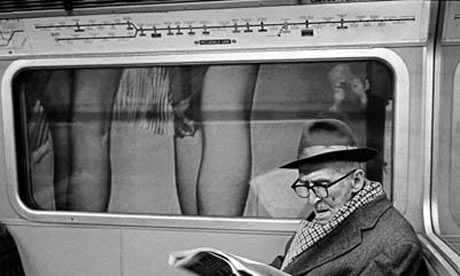
A man reads a paper on a London Underground train. Photograph: Peter Johns/Other
Not long after the first journey beneath the capital by rail, on January 9, 1863, the Underground began expanding rapidly. People wanted more. In its first year of existence 11.8 million journeys were taken on the Metropolitan Railway’s revolutionary new service, despite the steam and smoke and smell of sulphur. Things moved very fast. The first section of what became the District Line opened in 1868 and by 1884 the Circle Line was complete. Demand was vast. Entrepreneurs jostled to supply.
An appetite for more and better subterranean rail rides also rages today, but the forces driving it have changed. The great selling point of the earliest underground railways was that they (literally) undercut the congestion of the city’s streets. They then fulfilled and fed a desire for fast travel links above and below ground between the city and the cleaner, quieter life of the burgeoning suburbs.
Those sorts of factors continue to be in play, but the big, 21st century push factor is London’s booming population, predicted to soar from the present 8.3 million to around 10 million by 2030. The capital continues to buzz as a global business hub, its economic fortunes and its peoples’ prosperity bound up with this key part of its public transport system. How will all those people get in to London, through it and move around it? How can the Tube and the approaching advent of Crossrail best contribute to making a bigger London a better one too?
Among the planners, underestimates are not an option. Transport for London’s protracted Tube upgrade and improvement programme is still in part a catch-up operation following decades of under-investment. Just keeping pace with rapid change is described as a massive task: earlier this year, TfL commissioner Sir Peter Hendy predicted that when Crossrail opens for business in 2018 “it will be immediately full.”
That’s a daunting thought and raises some large questions. How is TfL running the great race to keep the city’s underground rail services up to speed? What are its ideas and options for coping with the challenge of providing so much more capacity? How large a part of the answer is underground rail compared with other transport modes, notably the London bus? Are the right questions being asked in the first place?
Over the coming weeks, as the London Underground’s 150th anniversary year approaches its end, I’ll be writing a string of articles about its future. Some parts of that future will start unfolding within weeks, others are already underway – have you been to Tottenham Court Road lately? – while some long-term solutions aren’t, as yet, much more than twinkles in visionaries’ eyes.
Tomorrow’s Tube will be shaped by everything from TfL developing new approaches to presenting and sharing information it holds about passenger preferences and behaviour to finding different ways of funding new infrastructure; from the recently-published proposals for re-modelling Bank station to the drawing board development of Crossrail 2 and the zygote notion of Crossrail 3; from managing the introduction of new train and ticketing technology to imagining how Tube stations might further evolve into something other than only transport destinations.
All these things, I think, merit reporting and exploring. But there are, I’m sure, many other angles I haven’t thought of. What aspects of the Underground’s future interest you most? Which parts of the story of Tomorrow’s Tube are you most excited or perturbed by? Is there specialised knowledge, far beyond my expertise, that you can share? The comment thread is open below. My email address is dave.hill@guardian.co.uk. I look forward to hearing from you.
FACEBOOK COMMENT by JETZTKAUFEN.INFO - best online store